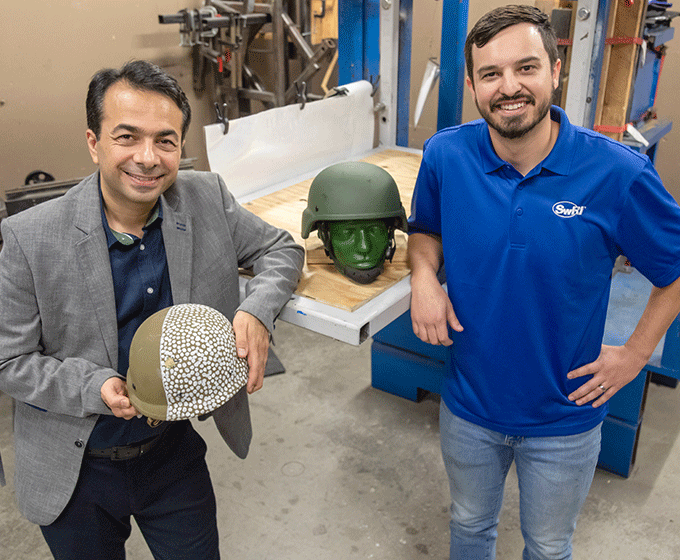
UTSA’s Dr. Morteza Seidi (left) and SwRI’s Dr. Daniel Portillo (right) are creating innovative military helmet pads designed to prevent traumatic brain injury (TBI). The project is supported by a $125,000 grant from the Connecting through Research Partnerships (Connect) program. Photo Courtesy of SwRI.
SEPTEMBER 16 2024 — Researchers from Southwest Research Institute (SwRI) and UTSA are creating innovative military helmet pads designed to prevent traumatic brain injury (TBI). The project, led by SwRI’s Daniel Portillo and UTSA’s Morteza Seidi, is supported by a $125,000 grant from the Connecting through Research Partnerships (Connect) program.
Traumatic brain injury can affect human performance and quality of life. It is a critical concern in military settings, where service members are regularly exposed to environments that pose significant risks for blast exposures, blunt trauma and ballistic impacts.
“The increasing incidence of TBI among military service members shows a pressing need for enhanced protective equipment in combat and training environments,” Portillo said. “The widespread use of improvised explosive devices and firearms has made TBIs particularly prevalent, and helmets are the primary form of protection against skull and brain injuries.”
SwRI and UTSA will collaborate on a helmet that includes multi-behavior padding that becomes soft or stiff depending on the type of impact the wearer experiences. During a blunt impact, such as a fall, the padding will soften to cushion against the blow. A ballistic impact from shrapnel or a bullet will make the padding stiffen to absorb the object’s kinetic energy and prevent injury to the skull and brain.
“Ballistic impacts occur at extremely high speeds,” Seidi said. “They are very different from blunt impacts at relatively lower speeds, which is why it’s challenging to create a helmet that can protect against both.”
SwRI’s Dan Nicolella and UTSA’s Marzieh Memar will lead the computer analysis of human brain response to evaluate the overall performance of padding in reducing the likelihood of brain injury.
The researchers will use 3D printing technology to build the helmet pads, and then test their ability to mitigate injury under various levels of both types of impacts, simulating real-world conditions. Blunt impact testing will occur at UTSA, while SwRI will conduct ballistic impact testing.
“By leveraging the unique expertise at UTSA and SwRI, we can improve the safety and wellbeing of military service members,” Portillo said.
SwRI’s Executive Office and the UTSA Office of Research sponsor the Connect program, which offers grant opportunities to enhance greater scientific collaboration between the two institutions.
UTSA Today is produced by University Communications and Marketing, the official news source of The University of Texas at San Antonio. Send your feedback to news@utsa.edu. Keep up-to-date on UTSA news by visiting UTSA Today. Connect with UTSA online at Facebook, Twitter, Youtube and Instagram.
Huddle Against Hunger is a fundraising competition with Texas State that benefits our Roadrunner Pantry. Donations this week will help UTSA earn additional prize monies provided by RBFCU.
In-Person and VirtualJoin UTSA Libraries for an update on federal public access policies and how the library can assist with compliance.
Virtual EventWe invite you to join us for Birds Up! Downtown, an exciting welcome back event designed to connect students with the different departments at the Downtown Campus. Students will have the opportunity to learn about some of the departments on campus, gain access to different resources, and collect some giveaways!
Bill Miller PlazaThere are many citation managers. Which one is right for you? This workshop will explain what a citation manager is and how it can help you organize your citations, insert citations as you write your paper, and generate your bibliography.
Virtual EventPubMed is an essential database for anyone conducting biomedical or health-related research. This workshop will teach attendees how to effectively navigate this free resource and locate peer-reviewed articles using advanced search features, MeSH subject headings, and Boolean operators.
Virtual EventIn this hands-on workshop, participants will learn to setup an EndNote library, save references and PDFs, and automatically create and edit a bibliography. Attendees are encouraged, but not required, to have EndNote already installed on a personal computer.
Virtual EventJoin UTSA Libraries and Museums to learn more about the publishing discounts available for UTSA researchers. Current agreements include Elsevier, Cambridge University Press, Wiley, and more. Bring your questions and feedback for the library as we continue to pursue partnerships with publishers to reduce costs for our researchers.
Virtual EventThe University of Texas at San Antonio is dedicated to the advancement of knowledge through research and discovery, teaching and learning, community engagement and public service. As an institution of access and excellence, UTSA embraces multicultural traditions and serves as a center for intellectual and creative resources as well as a catalyst for socioeconomic development and the commercialization of intellectual property - for Texas, the nation and the world.
To be a premier public research university, providing access to educational excellence and preparing citizen leaders for the global environment.
We encourage an environment of dialogue and discovery, where integrity, excellence, respect, collaboration and innovation are fostered.